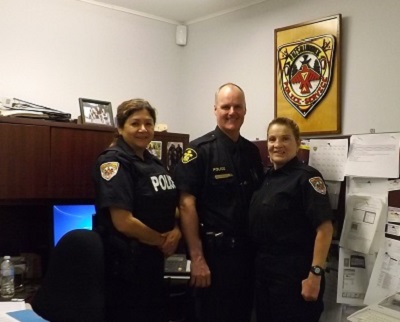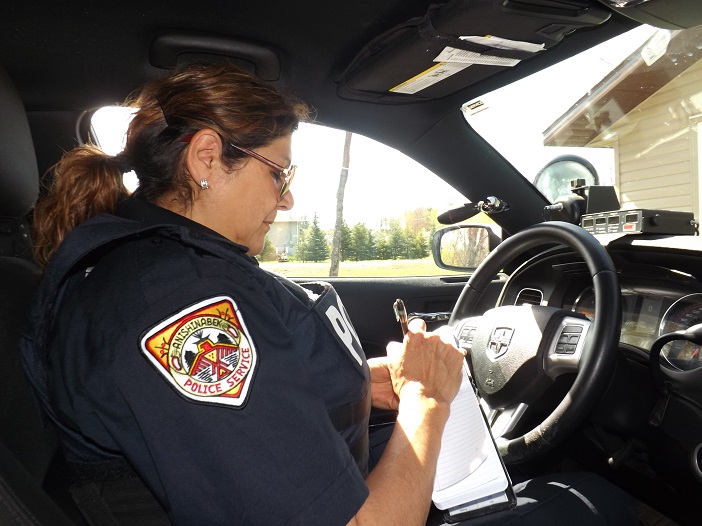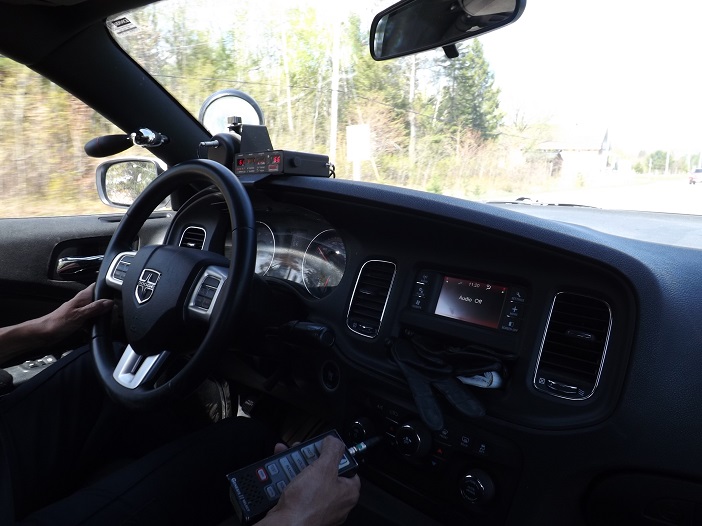It’s been almost month since an Ontario Court acquitted Terry Mosher of charges connected to the death of 22 year old Jessie James Roach. The decision created an uproar and residents of Garden River, and supporters, took over Highway 17B, where Jessie was killed, to send a message to motorists to ‘just go around’. Highway 17B runs through the Garden River First Nation community. In 2007, a bypass around the reserve was established –the result of decades of many Chiefs and Councils lobbying the government for an extension around Garden River to increase safety for its pedestrian and motorist residents.

(left to right) Constable Marlene Martin-Anishinabek Police Services, Constable Brian Speakman -OPP Sault detachment, Sergeant Karen Bell -Anishinabek Police Services
Sergeant Karen Bell has been an officer for 28 years- twenty-five of those have been served in the Garden River community with the Anishinabek Police Services. Of the tragedy and recurring accidents along Highway 17B, Sergeant Bell has seen it all.
“When I first started policing here there was a significant amount of fatalities as well as a lot of injuries and property damage incidents because of accidents. A lot of it had to do with speeding,” remarked Bell. “Since the 4-lane opened a lot of heavy traffic has been diverted onto the new highway. The amount of accidents and fatalities has reduced significantly.”
The responsibility of patrolling Highway 17B is shared between the Ontario Provincial Police and Anishinabek Police Services. Sault Ste. Marie OPP Constable, Brian Speakman, has patrolled the area for 23 years. “This is a community issue. Our officers are making diligent efforts to do the enforcement on the road and keep people slowing down,” commented Speakman.
Bell and Speakman have both observed that despite the opening of the bypass many residents in neigbhouring communities have a preference for their familiar route through Garden River.

“A lot of people that I pull over are from Echo Bay and Bruce Mines. I think for people in Echo Bay it’s shorter than using the bypass.” ~ Constable Marlene Martin, Anishinabek Police Services
“There is still a lot of people that live in the Echo Bay, Desbarats and Bruce Mines area that prefer to take this route,” commented Bell. “A lot of the elderly people like to take this route as well because there are homes along the way. If something happens to them they can stop and ask a resident for help. Where if you go out there,” adds Bell, waving her arm indicating the bypass behind her, “There isn’t any building on that four-lane highway. It’s very intimidating. Its pitch black over there.”
Efforts to divert or slow traffic down have been ongoing for years. In addition to lobbying and protests, signage warning motorists to follow speed limits has been installed along the most resident-active areas of Highway 17B.
“You’ll notice the pedestrian walking sign,” commented Speakman. “When you travel through First Nation communities across Ontario, you see those signs all the time. The reason you see those signs is because the community has a different dynamic to it.”
Added Bell, “So many Garden River people walk along the highway and cross the highway. Everybody knows one another- their sister lives across the highway or their Auntie lives four houses down. They’re always walking everywhere. It’s such a tight community.”
Many First Nations communities and rural communities have been developed around provincial highways. As a result, slowing the traffic down, or traffic calming, is often a shared concern for these little villages and towns. The Town of Bruce Mines is about 40 km east of Garden River and Highway 17 runs directly through its main corridor. While the small town has not experienced the overwhelming number of fatalities as Garden River’s Highway 17B, those that live there have been concerned about the safety of pedestrian and motorist residents and in particular their children. Immediately off the highway is the town’s elementary school. Efforts years ago to establish various features that would cue drivers to slow down were road blocked by a common challenge- no funding.
Traffic calming measures may lead to actual road obstructions like the creation of road islands but more often visual cues and enhancements are established to indicate to motorists that the function of the road –of the highway, has changed. There is the obvious installation of sidewalks and lighting in addition to paint applications to the roadway. ‘Chevrons’ –shaped like an inverted ‘V’, can be painted on the road way in various intervals that gives drivers the perception of driving too fast or speeding up which encourages motorists to reduce their speed. Lane narrowing can be applied by painting an expansion of the shoulder of the road for walkers and cyclists, and painted speed limits and warnings directly on the road have been shown to be practical and effective.
When the homes, schools and mom and pop corner stores dotting the highway aren’t obvious cues that pedestrians are sharing the roadway, some communities have taken on creative aesthetic approaches to slowing down traffic by creating strong visual markers. Erecting welcoming gates at either end of the town, installing billboard artwork along the road, establishing tall posts along a section of pedestrian-heavy traffic to hang seasonal decorations like baskets of flowers or creating outdoor seating outside of locally owned coffee shops or parkettes along the road are effective psychological jolts alerting motorists that they are entering an area where children, pets, elderly and regular pedestrians are active.
Garden River Band Chief, Paul Syrette, has commented that the Council is actively pursuing options with the government to establish measures that will address traffic through Garden River. “Our community is set to meet with Ministry of Transportation regional reps on the 26th of May to do follow up to the highway demonstration and discuss next steps and options to address the highway 17B traffic concerns.”
Currently, tracking the number of speeding tickets issued along Highway 17B is challenging. An exact number was not available through Anishinabek Police Services at the time of publication and the OPP have a tedious, manual system for tracking tickets issued in Garden River.
Speakman explained that the OPP are addressing this challenge. “We’ll be updating our analytics to show where the location of the ticket occurred. Right now we just know that they were issued on Highway 17. We want to identify hot spots and troubled spots so we can focus resources on those problem areas,” remarked Speakman then adding, “The highway is the most dangerous place that I work as a police officer.”
In the meantime, officers encourage pedestrians to be safe and exercise precaution when walking along Highway 17B. “People are crossing the highway or just walking a third of a kilometer down the road to see their Auntie. There’s children running across the road- not realizing that it’s a provincial highway,” indicated Sergeant Bell once again, that to residents of Garden River the highway is a road to family and friends. It isn’t always at the forefront of their minds that Highway 17B is a danger zone. Adding of safety precautions Bell states, “Sometimes they’re not walking facing traffic, they’re not walking with reflectors. Those are safety things that we encourage people to do.”
Many thanks to Anishinabek Police Services for the fascinating opportunity to ride-a-long. Thank you for your service!
*****
(feature image: Nabbed by Constable Marlene Martin -who hummed just a little bit as she wrote up this ticket.)


